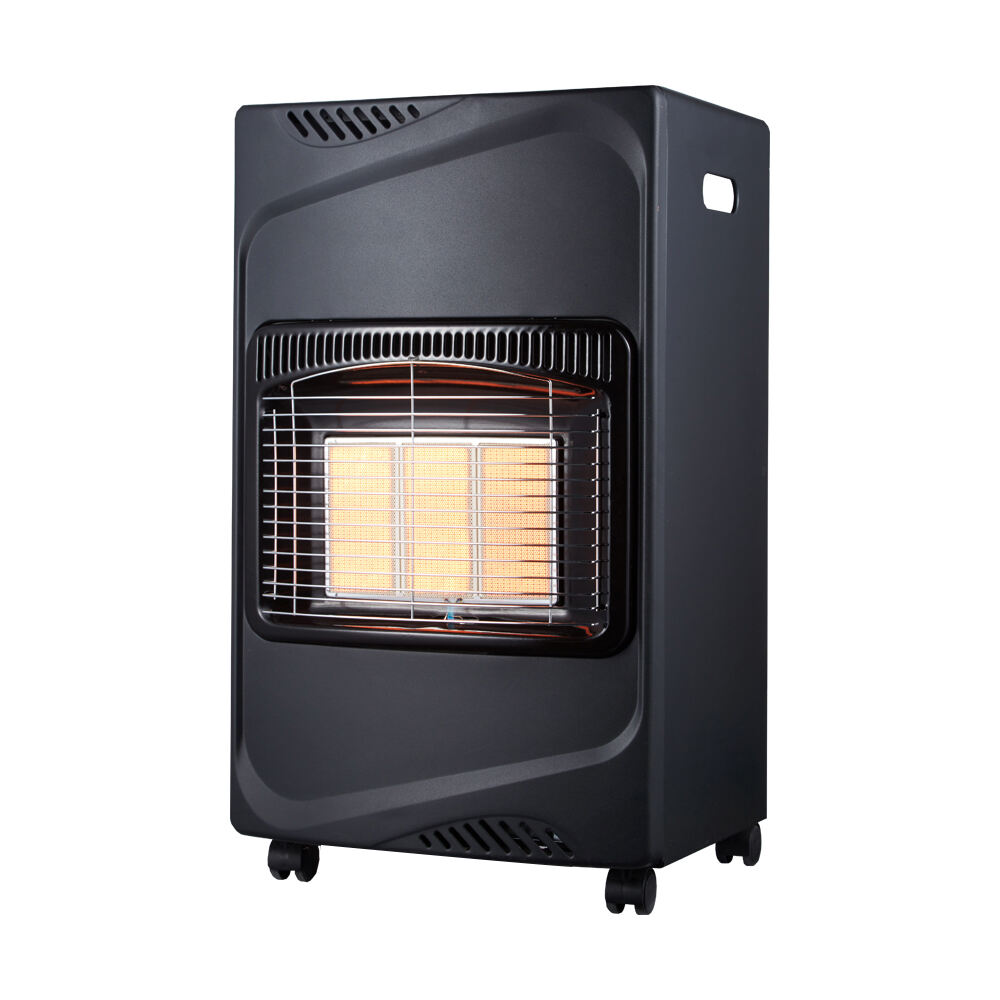Guide to Choose a Portable Gas Heater for Camping
When the temperature drops during outdoor adventures, staying warm becomes a critical priority for campers and outdoor enthusiasts. A reliable portable gas heater can transform your camping experience from uncomfortable and cold to cozy and enjoyable. These versatile heating devices offer efficient warmth without requiring electrical connections, making them perfect for remote camping locations where traditional heating options are unavailable.

Selecting the right heating solution requires careful consideration of various factors including fuel type, heating capacity, safety features, and portability requirements. Modern gas heaters designed for camping have evolved significantly, offering improved efficiency, enhanced safety mechanisms, and compact designs that fit seamlessly into your outdoor gear collection. Understanding these features helps ensure you choose a heater that meets your specific camping needs while maintaining safety standards.
The market offers numerous options ranging from compact single-burner units to larger models capable of heating substantial tent spaces. Each type comes with distinct advantages and limitations that affect performance in different camping scenarios. Making an informed decision involves evaluating your typical camping conditions, group size, and heating requirements to find the optimal balance between warmth, portability, and fuel efficiency.
Understanding Gas Heater Types and Technologies
Butane versus Propane Fuel Systems
Butane and propane represent the two primary fuel options for camping gas heaters, each offering unique performance characteristics. Butane cartridges provide convenient, lightweight fuel storage and excellent performance in moderate temperature conditions. These cartridges typically feature simple connection systems that allow quick setup and fuel replacement during camping trips. However, butane performance diminishes significantly in cold weather, making it less suitable for winter camping or high-altitude adventures where temperatures frequently drop below freezing.
Propane fuel systems deliver consistent performance across a wider temperature range, maintaining effectiveness even in cold conditions that would render butane heaters ineffective. Propane canisters generally offer longer burn times and higher heat output per unit of fuel, making them ideal for extended camping trips or larger group heating requirements. The trade-off involves increased weight and bulk compared to butane systems, which may impact portability considerations for backpacking or minimalist camping approaches.
Ceramic versus Catalytic Heating Elements
Ceramic heating elements utilize radiant heat transfer, producing infrared radiation that directly warms objects and people within the heater's range. This technology provides immediate warmth upon ignition and creates focused heating zones ideal for personal warming or heating small enclosed spaces. Ceramic elements typically operate at higher temperatures and produce visible light during operation, making them easily identifiable when active for safety purposes.
Catalytic heaters employ chemical processes to generate heat without flames, creating consistent warmth through controlled combustion reactions. These systems operate at lower surface temperatures while providing steady heat output over extended periods. Catalytic technology offers improved fuel efficiency and reduced oxygen consumption compared to traditional flame-based heaters, making them suitable for partially enclosed spaces with adequate ventilation requirements.
Safety Considerations and Ventilation Requirements
Carbon Monoxide Prevention Strategies
Carbon monoxide poses a serious safety risk when using any combustion-based heating device in enclosed or semi-enclosed spaces. Gas heaters consume oxygen during operation while producing carbon monoxide as a byproduct, creating potentially dangerous conditions without proper ventilation. Understanding these risks and implementing appropriate safety measures prevents accidental poisoning and ensures safe heating during camping activities.
Proper ventilation requires maintaining adequate air circulation even when seeking to retain heat within tents or shelters. Opening tent vents, leaving entrance flaps partially unzipped, or creating controlled air gaps ensures fresh oxygen supply while allowing dangerous gases to escape. Never operate gas heaters in completely sealed spaces, and always turn off heating devices before sleeping to prevent overnight carbon monoxide accumulation.
Stability and Tip-Over Protection
Modern portable gas heater designs incorporate various safety mechanisms to prevent accidents and injuries during outdoor use. Tip-over switches automatically shut off gas flow when heaters are knocked over or tilted beyond safe operating angles. These safety features prevent fuel leaks, uncontrolled flames, and potential fire hazards that could occur during camping activities where equipment may be accidentally disturbed.
Base stability features including wide footprints, low centers of gravity, and anti-slip surfaces help prevent accidental tipping during normal operation. Some models include weighted bases or stake-down options for enhanced stability on uneven terrain commonly encountered at camping sites. Evaluating these safety features ensures reliable operation and reduces risks associated with outdoor heating equipment use.
Sizing and Heating Capacity Calculations
BTU Requirements for Different Space Sizes
British Thermal Units measure heating capacity and help determine appropriate heater sizing for specific camping applications. Small one-person tents typically require 1,000 to 3,000 BTU capacity for adequate warmth, while family-sized tents or camping shelters may need 5,000 to 9,000 BTU output depending on internal volume and insulation characteristics. Understanding these calculations prevents under-heating situations that leave campers cold and uncomfortable during outdoor adventures.
Environmental factors significantly impact heating requirements beyond basic space volume calculations. Wind exposure, altitude, ambient temperature, and tent insulation quality all affect actual heating needs for comfortable camping conditions. Higher altitudes and windy conditions increase heat loss, requiring heaters with greater capacity to maintain desired internal temperatures throughout changing weather conditions.
Fuel Consumption and Runtime Estimates
Fuel efficiency directly impacts camping logistics, affecting both equipment weight and resupply requirements for extended trips. High-output heaters consume fuel more rapidly, requiring larger fuel supplies or more frequent cartridge changes during multi-day camping adventures. Calculating expected runtime based on heater specifications and typical usage patterns helps plan adequate fuel quantities for entire camping trips without running short during critical heating periods.
Runtime calculations must account for variable usage patterns throughout camping trips, including peak heating demands during cold nights and reduced usage during warmer periods. Most manufacturers provide consumption rates at maximum output, but actual usage typically involves variable heat settings that extend overall runtime. Planning fuel supplies with 25-50% safety margins ensures adequate heating capacity even when conditions require higher output than initially anticipated.
Portability and Weight Considerations
Compact Design Features
Modern camping heaters prioritize space-efficient designs that minimize packed volume without compromising heating performance. Foldable components, telescoping elements, and nested construction allow substantial size reduction during transportation and storage. These design innovations enable backpackers and car campers to include effective heating solutions without exceeding weight or space limitations imposed by other essential camping gear requirements.
Integrated carrying cases and protective storage solutions preserve heater components during transportation while providing organized storage for fuel cartridges and accessories. Hard cases offer maximum protection for delicate components, while soft cases reduce weight and bulk for weight-conscious camping applications. Evaluating storage solutions alongside heater performance ensures complete heating systems that survive transportation rigors without damage or component loss.
Transportation and Setup Ease
Quick-setup mechanisms reduce complexity and time requirements for deploying heating systems at camping sites. Tool-free assembly processes enable rapid deployment even in cold conditions when manual dexterity may be reduced. Simple connection systems, clearly marked components, and intuitive controls ensure reliable operation without requiring technical expertise or extensive setup procedures during outdoor adventures.
Transportation considerations extend beyond weight and size to include vibration resistance, temperature tolerance, and impact protection during travel to camping destinations. Robust construction materials and protective component design ensure heaters remain functional after exposure to vehicle vibrations, temperature variations, and handling stresses encountered during camping trip preparations and site-to-site transportation requirements.
Operating Efficiency and Performance Factors
Heat Distribution Patterns
Understanding heat distribution characteristics helps optimize heater placement and maximize warming efficiency within camping spaces. Radiant heaters produce directional heat that warms objects and surfaces in their line of sight, making them effective for personal warming or heating specific areas within larger spaces. Positioning radiant heaters requires consideration of obstacles, reflective surfaces, and occupant locations to ensure effective heat delivery where needed most.
Convection-based heating systems create air circulation patterns that distribute warmth throughout enclosed spaces more evenly than radiant systems. These heaters work well in tents and shelters where uniform temperature distribution improves overall comfort for multiple occupants. However, convection systems may require longer warm-up periods and can be less efficient in poorly insulated or highly ventilated camping environments where heated air easily escapes.
Altitude and Weather Performance
High-altitude camping presents unique challenges for gas heater performance due to reduced oxygen density and lower atmospheric pressure. These conditions affect combustion efficiency and may require heaters specifically designed for high-altitude operation. Some models include altitude compensation features or adjustable air intake systems that maintain performance across varying elevation conditions encountered during mountain camping adventures.
Weather resistance features protect heater components from moisture, wind, and temperature variations common during outdoor use. Wind screens, moisture-resistant controls, and weatherproof housing materials ensure reliable operation despite challenging environmental conditions. These features become particularly important during extended camping trips where equipment failure could compromise safety and comfort in remote locations without easy replacement options.
Maintenance and Long-Term Durability
Cleaning and Component Care
Regular maintenance extends heater lifespan and ensures safe, efficient operation throughout multiple camping seasons. Cleaning procedures typically involve removing dust, debris, and insect nests that can accumulate in air intake areas and affect combustion efficiency. Proper cleaning techniques using appropriate tools and cleaning agents prevent damage to delicate components while maintaining optimal airflow and heat transfer characteristics.
Component inspection schedules help identify wear patterns, connection looseness, and potential failure points before they cause operational problems during camping trips. Regular examination of fuel connections, heating elements, safety switches, and control mechanisms enables preventive maintenance that avoids field failures in remote camping locations where replacement parts or repair services are unavailable.
Storage and Seasonal Preparation
Proper off-season storage protects heater components from corrosion, pest damage, and environmental degradation during periods of non-use. Storage procedures typically involve thorough cleaning, fuel system purging, and protective coating application to metal components susceptible to moisture damage. Climate-controlled storage environments prevent temperature cycling damage and humidity-related deterioration that can affect heater reliability and safety systems.
Pre-season preparation routines ensure heaters function correctly after storage periods and before critical camping deployments. Testing procedures include fuel system checks, ignition verification, safety switch operation, and heat output validation under controlled conditions. Conducting these tests at home prevents discovering equipment failures at remote camping locations where alternative heating options may be unavailable or inadequate for prevailing conditions.
FAQ
What safety precautions should I follow when using a gas heater in a tent
Always ensure adequate ventilation by keeping tent vents open and never completely sealing the tent while the heater operates. Install battery-powered carbon monoxide detectors and never use the heater while sleeping. Maintain clearance around the heater according to manufacturer specifications and keep the unit on stable, level ground away from tent walls and flammable materials.
How do I determine the right heater size for my camping needs
Calculate your space volume and multiply by 10-15 BTU per cubic foot for basic heating requirements. Consider additional factors like altitude, wind exposure, and tent insulation quality that increase heating demands. For most family camping tents, heaters producing 4,000-7,000 BTU provide adequate warmth while maintaining reasonable fuel consumption and portability characteristics.
Can I use a gas heater at high altitude camping locations
Many gas heaters function adequately at moderate altitudes up to 8,000-10,000 feet, but performance may decrease due to thinner air and reduced oxygen availability. Some manufacturers produce altitude-compensated models designed specifically for high-elevation use. Always check manufacturer specifications and consider carrying backup heating options for extreme altitude camping where standard heaters may not provide adequate performance.
How long will fuel cartridges last during typical camping use
Fuel consumption varies significantly based on heater output settings, runtime duration, and environmental conditions. A standard 8-ounce butane cartridge typically provides 2-4 hours of operation at maximum output, or 6-12 hours at lower heat settings. Plan fuel supplies based on expected nightly usage patterns and carry 25-50% extra fuel capacity to account for unexpectedly cold weather or extended heating requirements.







